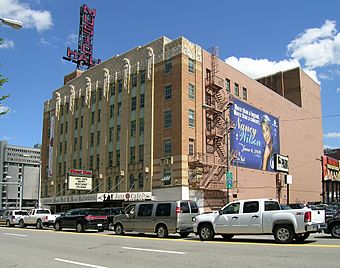Music Hall Center for the Performing Arts facts for kids
|
Wilson Theatre, Detroit Music Hall
|
|
 |
|
| Address | 350 Madison Street Detroit, Michigan United States |
|---|---|
| Capacity | 1,731 |
| Current use | Performing arts center |
| Opened | 1928 |
|
Wilson Theatre
|
|
| Architect | William Kapp; Smith, Hinchman & Grylls |
| NRHP reference No. | 77000725 |
| Significant dates | |
| Added to NRHP | August 9, 1977 |
The Music Hall Center for the Performing Arts is a cool theater in Detroit, Michigan. It has 1,731 seats, which is a lot of space for shows! You can find it in Detroit's theater area, at 350 Madison Street.
This building first opened in 1928. Back then, it was called the Wilson Theatre. It became a Michigan State Historic Site in 1976. A year later, in 1977, it was added to the National Register of Historic Places. This means it's a very important historical building!
Contents
The Story of the Music Hall
How It All Started
The story of the Music Hall begins with two brothers, John Francis Dodge and Horace Elgin Dodge. They were early investors in the Ford Motor Company. Later, they sold their part to Henry Ford and started their own car company, Dodge, in 1914.
Sadly, both brothers passed away in 1920. This left their wives with a lot of money.
Matilda Dodge Wilson's Dream
One of the wives, Matilda Dodge Wilson, loved stage shows. She married Alfred Wilson in 1925. Matilda decided to use some of her money to build a special place in Detroit. She wanted it to be a home for a theater group. It would also host famous Broadway shows that traveled around.
Matilda hired a well-known Detroit architecture company, Smith, Hinchman & Grylls. They asked William Kapp to design the building. They spent $1.5 million to build it! When it opened in 1928, everyone called it the Wilson Theatre.
About the Building's Design
Art Deco Style
William Kapp designed the Wilson Theater to be six stories tall. He used a popular style called Art Deco. The front of the building, facing Madison Street, looks amazing. It has orange and tan bricks. You can also see special tiles from Pewabic Pottery and stone decorations.
Cool Details
The top part of the building has seven sections. These sections are separated by stone pillars. Each pillar has a cool terra cotta mask at the top. In the middle five sections, there are two windows. The sections at each end have one window. The very top of the building has coral and green Pewabic tiles. They are arranged in a pretty quatrefoil pattern. The street level part of the building has smooth travertine stone. It also has green marble at the bottom.
Inside the Theater
When it first opened, the inside of the theater looked like a Spanish palace. It had a style called Spanish Renaissance. There were 1,800 seats for people to watch shows. The lounge area on the lower floor even had a built-in bar.
What Happened Next
New Names and Uses
During the Great Depression, many people had little money. The Detroit Symphony Orchestra struggled to keep its own building. So, in 1946, the orchestra moved into the Wilson Theatre. They changed its name to Detroit Music Hall.
The symphony stayed there until 1956. Then, they moved to a new building called Ford Auditorium. After that, the Music Hall was used for other things. It even became a movie theater that showed special Cinerama films.
Home for Opera
In 1971, a new opera company started in Michigan. It was called the Michigan Opera Theatre. The Music Hall became their main home. They performed most of their shows there until 1984.
Restoration and Recognition
People started working to fix up the theater in 1973. These efforts continued for several years. In 1974, the building got its current name: the Music Hall Center for the Performing Arts. It is the only theater left in Detroit that was built just for live performances.
The theater was added to the Michigan Register of Historic Places in 1976. It was also listed on the National Register of Historic Places in 1977. A special historical marker was placed at its entrance in 1978. This marker tells everyone about the building's important history.
See also
 In Spanish: Music Hall Center for the Performing Arts para niños
In Spanish: Music Hall Center for the Performing Arts para niños

